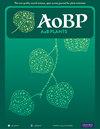竞争和干旱以非加成方式影响一年生芦苇 "抱子甘蓝"(Lamium amplexicaule)的雌雄同株率
IF 2.4
3区 生物学
Q2 ECOLOGY
引用次数: 0
摘要
背景与目的 竞争通过限制可用的非生物或生物资源(如养分、水、空间或传粉媒介)影响混合交配策略。克利斯朵雄花物种会同时开出封闭型(克利斯朵雄花,CL)和开放型(克利斯朵雄花,CH)花朵,前者必须自交,后者可能外交。种内竞争对适应性和裂殖变异的影响范围很广,从因资源限制而限制成本高昂的 CH 花的生产,到因外交 CH 后代的适应性优势而有利于 CH 花的生产。此外,当竞争与其他环境变异同时发生时,竞争的影响也会发生变化。方法 我们在一个结合了干旱、种间竞争和季节变化的普通花园实验中,种植了来自不同气候和栖息地的七个原生植物种群的植物。结果表明,所有这些参数本身都会影响该物种的雌雄异株程度。主要结果 在春季,竞争和干旱对适应性有负面影响,但只有当植物同时受到这两种处理时,CL比例才会增加。我们在秋季没有观察到同样的结果,这可能是由于非适应性表型变异或季节间土壤紧实度的差异造成的。观察到的反应主要归因于表型可塑性,但我们也观察到不同种群在形态、表型和裂殖性状上的表型差异,这表明存在不同的生态型。结论 我们的数据并不支持资源稀缺时CL比例会降低的假说,因为生长减弱的植株CL比例相对较低。我们认为,裂殖现象的变异可能是对授粉者丰度的一种适应,也可能是对自交种子和外交种子的后代之间取决于环境的适应性差异的一种适应,这两种假说都值得进一步研究。这为研究混合交配系统的维持提供了令人兴奋的新可能性,我们可以利用清配种物种作为模型,将近亲繁殖和繁殖成本的影响结合起来。本文章由计算机程序翻译,如有差异,请以英文原文为准。
Competition and drought affect cleistogamy in a non-additive way in the annual ruderal Lamium amplexicaule
Backgrounds and aims Competition affects mixed-mating strategies by limiting available abiotic or biotic resources such as nutrients, water, space, or pollinators. Cleistogamous species produce closed (cleistogamous, CL), obligately selfed, simultaneously with open (chasmogamous, CH), potentially outcrossed flowers. The effects of intraspecific competition on fitness and cleistogamy variation can range from limiting the production of costly CH flowers because of resource limitation, to favouring CH production because of fitness advantages of outcrossed, CH offspring. Moreover, the effects of competition can be altered when it co-occurs with other environmental variation. Methods We grew plants from seven populations of the ruderal Lamium amplexicaule, originating from different climates and habitats, in a common garden experiment combining drought, interspecific competition, and seasonal variation. All these parameters have been shown to influence the degree of cleistogamy in the species on their own. Key results In spring, competition and drought negatively impacted fitness, but the CL proportion only increased when plants were exposed to both treatments combined. We did not observe the same results in autumn, which can be due to non-adaptive phenotypic variation, or to differences in soil compactness between seasons. The observed responses are largely due to phenotypic plasticity, but we also observed phenotypic differentiation between populations for morphological, phenological, and cleistogamy traits, pointing to the existence of different ecotypes. Conclusions Our data do not support the hypothesis that CL proportion should decrease when resources are scarce, as plants with reduced growth had relatively low CL proportions. We propose that variation in cleistogamy could be an adaptation to pollinator abundance, or to environment-dependent fitness differences between offspring of selfed and outcrossed seeds, two hypotheses worth further investigation. This opens exciting new possibilities for the study of the maintenance of mixed-mating systems using cleistogamous species as models which combine effects of inbreeding and reproductive costs.
求助全文
通过发布文献求助,成功后即可免费获取论文全文。
去求助
来源期刊

AoB Plants
PLANT SCIENCES-
CiteScore
4.80
自引率
0.00%
发文量
54
审稿时长
20 weeks
期刊介绍:
AoB PLANTS is an open-access, online journal that has been publishing peer-reviewed articles since 2010, with an emphasis on all aspects of environmental and evolutionary plant biology. Published by Oxford University Press, this journal is dedicated to rapid publication of research articles, reviews, commentaries and short communications. The taxonomic scope of the journal spans the full gamut of vascular and non-vascular plants, as well as other taxa that impact these organisms. AoB PLANTS provides a fast-track pathway for publishing high-quality research in an open-access environment, where papers are available online to anyone, anywhere free of charge.
 求助内容:
求助内容: 应助结果提醒方式:
应助结果提醒方式:


